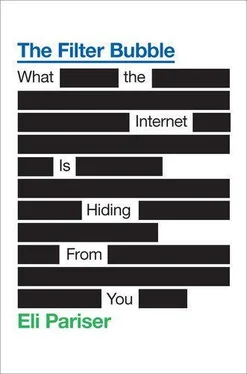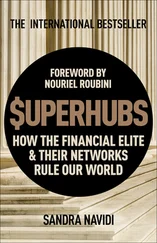Second, personalization filters will get better and better at overlaying themselves on individuals’ recommendations. Like your friend Sam’s posts on football but not his erratic musings on CSI ? A filter watching and learning which pieces of content you interact with can start to sift one from another—and undermine even the limited leadership that a group of friends and pundits can offer. Google Reader, another product from Google that helps people manage streams of posts from blogs, now has a feature called Sort by Magic, which does precisely this.
This leads to the final way in which the future of media is likely to be different than we expected. Since its early days, Internet evangelists have argued that it was an inherently active medium. “We think basically you watch television to turn your brain off, and you work on your computer when you want to turn your brain on,” Apple founder Steve Jobs told Macworld in 2004.
Among techies, these two paradigms came to be known as push technology and pull technology. A Web browser is an example of pull technology: You put in an address, and your computer pulls information from that server. Television and the mail, on the other hand, are push technologies: The information shows up on the tube or at your doorstop without any action on your end. Internet enthusiasts were excited about the shift from push to pull for reasons that are now pretty obvious: Rather than wash the masses in waves of watered-down, lowest-common-denominator content, pull media put users in control.
The problem is that pull is actually a lot of work. It requires you to be constantly on your feet, curating your own media experience. That’s way more energy than TV requires during the whopping thirty-six hours a week that Americans watch today.
In TV network circles, there’s a name for the passive way with which Americans make most of those viewing decisions: the theory of least objectionable programming. Researching TV viewers’ behavior in the 1970s, pay-per-view innovator Paul Klein noticed that people quit channel surfing far more quickly than one might suspect. During most of those thirty-six hours a week, the theory suggests, we’re not looking for a program in particular. We’re just looking to be unobjectionably entertained.
This is part of the reason TV advertising has been such a bonanza for the channel’s owners. Because people watch TV passively, they’re more likely to keep watching when ads come on. When it comes to persuasion, passive is powerful.
While the broadcast TV era may be coming to a close, the era of least objectionable programming probably isn’t—and personalization stands to make the experience even more, well, unobjectionable. One of YouTube’s top corporate priorities is the development of a product called LeanBack, which strings together videos in a row to provide the benefits of push and pull. It’s less like surfing the Web and more like watching TV—a personalized experience that lets the user do less and less. Like the music service Pandora, LeanBack viewers can easily skip videos and give the viewer feedback for picking the next videos—thumbs up for this one, thumbs down for these three. LeanBack would learn. Over time, the vision is for LeanBack to be like your own personal TV channel, stringing together content you’re interested in while requiring less and less engagement from you.
Steve Jobs’s proclamation that computers are for turning your brain on may have been a bit too optimistic. In reality, as personalized filtering gets better and better, the amount of energy we’ll have to devote to choosing what we’d like to see will continue to decrease.
And while personalization is changing our experience of news, it’s also changing the economics that determine what stories get produced.
The offices of Gawker Media, the ascendant blog empire based in SoHo, look little like the newsroom of the New York Times a few miles to the north. But the driving difference between the two is the flat-screen TV that hovers over the room.
This is the Big Board, and on it are a list of articles and numbers. The numbers represent the number of times each article has been read, and they’re big: Gawker’s Web sites routinely see hundreds of millions of page views a month. The Big Board captures the top posts across the company’s Web sites, which focus on everything from media (Gawker) to gadgets (Gizmodo) to porn (Fleshbot). Write an article that makes it onto the Big Board, and you’re liable to get a raise. Stay off it for too long, and you may need to find a different job.
At the New York Times, reporters and bloggers aren’t allowed to see how many people click on their stories. This isn’t just a rule, it’s a philosophy that the Times lives by: The point of being the newspaper of record is to provide readers with the benefit of excellent, considered editorial judgment. “We don’t let metrics dictate our assignments and play,” New York Times editor Bill Keller said, “because we believe readers come to us for our judgment, not the judgment of the crowd. We’re not ‘American Idol.’” Readers can vote with their feet by subscribing to another paper if they like, but the Times doesn’t pander. Younger Times writers who are concerned about such things have to essentially bribe the paper’s system administrators to give them a peek at their stats. (The paper does use aggregate statistics to determine which online features to expand or cut.)
If the Internet’s current structures mostly tend toward fragmentation and local homogeneity, there is one exception: The only thing that’s better than providing articles that are relevant to you is providing articles that are relevant to everyone. Traffic watching is a new addiction for bloggers and managers—and as more sites publish their most-popular lists, readers can join in the fun too.
Of course, journalistic traffic chasing isn’t exactly a new phenomenon: Since the 1800s, papers have boosted their circulations with sensational reports. Joseph Pulitzer, in honor of whom the eponymous prizes are awarded each year, was a pioneer of using scandal, sex, fearmongering, and innuendo to drive sales.
But the Internet adds a new level of sophistication and granularity to the pursuit. Now the Huffington Post can put an article on its front page and know within minutes whether it’s trending viral; if it is, the editors can kick it by promoting it more heavily. The dashboard that allows editors to watch how stories are doing is considered the crown jewel of the enterprise. Associated Content pays an army of online contributors small amounts to troll search queries and write pages that answer the most common questions; those whose pages see a lot of traffic share in the advertising revenue. Sites like Digg and Reddit attempt to turn the whole Internet into a most-popular list with increasing sophistication, by allowing users to vote submitted articles from throughout the Web onto the site’s front page. Reddit’s algorithm even has a kind of physics built into it so that articles that don’t receive a constant amount of approval will begin to fade, and its front page mixes the articles the group thinks are most important with your personal preferences and behavior—a marriage of the filter bubble and the most-popular list.
Las Últimas Noticias, a major paper in Chile, began basing its content entirely on what readers clicked on in 2004: Stories with lots of clicks got follow-ups, and stories with no clicks got killed. The reporters don’t have beats anymore—they just try to gin up stories that will get clicks.
At Yahoo’s popular Upshot news blog, a team of editors mine the data produced by streams of search queries to see what terms people are interested in, in real time. Then they produce articles responsive to those queries: When a lot of people search for “Obama’s birthday,” Upshot produces an article in response, and soon the searchers are landing on a Yahoo page and seeing Yahoo advertising. “We feel like the differentiator here, what separates us from a lot of our competitors is our ability to aggregate all this data,” the vice president of Yahoo Media told the New York Times. “This idea of creating content in response to audience insight and audience needs is one component of the strategy, but it’s a big component.”
Читать дальше











